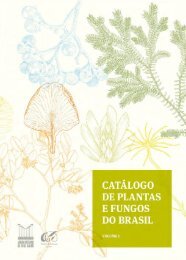A TAXONOMIC REVISION OF HYMENOPHYLLACEAE
A TAXONOMIC REVISION OF HYMENOPHYLLACEAE
A TAXONOMIC REVISION OF HYMENOPHYLLACEAE
Create successful ePaper yourself
Turn your PDF publications into a flip-book with our unique Google optimized e-Paper software.
10<br />
BLUMEA — Vol. 51, No. 2, 2006<br />
Hymenophyllum Sm. subsect. Plumosa Prantl (1875) 55. — Lectotype: Hymenophyllum plumosum<br />
Kaulf. (selected by Morton (1968) 169).<br />
Hymenophyllum Sm. subg. Apteropteris Copel. (1937) 176. — Apteropteris (Copel.) Copel. (1938b)<br />
34. — Hymenophyllum Sm. sect. Apteropteris (Copel.) C.V. Morton (1968) 170. — Sphaerocionium<br />
C. Presl subg. Apteropteris (Copel.) K. Iwats. (1984) 173. — Type: Hymenophyllum<br />
malingii (Hook.f.) Mett.<br />
Rhizomes long-creeping, filiform, usually covered with stellate hairs. Stipes to 18 cm<br />
long. Blades pinnate to tripinnatifid, elliptic to subdeltate, 165 by 17 cm, covered with<br />
stellate hairs, or with simple hairs. Sori at the tips of ultimate segments, bivalvate or<br />
tubular, lips entire, receptacles included or slightly extruded from involucres.<br />
Distribution — Cosmopolitan, highly diversified in the Neotropics; c. 70 species.<br />
Habitat — Epiphytic on tree trunks.<br />
Chromosome base number — x = 36.<br />
Note — Though the Sphaerocionium species characterized by their stellate hairs<br />
have sometimes been treated as an independent genus (e.g., Copeland, 1938b; Iwatsuki,<br />
1984), we reduced them to a subgenus of Hymenophyllum for the reason noted<br />
in the description of the genus. Our present definition of Sphaerocionium also includes<br />
most of the Microtrichomanes species (Ebihara et al., 2004) whose hairs have been<br />
transformed from stellate into simple. Although Morton (1947) subdivided this group<br />
chiefly by the nature and placement of the hairs, recent studies (Ebihara et. al., 2004,<br />
Hennequin et al., in press) suggest their phylogenetic relationships are more closely<br />
related to their geographical distributions.<br />
RepResentative species:<br />
Hymenophyllum adiantoides Bosch; H. aeruginosum (Poir.) Carmich.; H. amabile C.V. Morton;<br />
H. angustum Bosch; H. antillense (Jenman) Jenman; H. braithwaitei Ebihara & K. Iwats.;<br />
H. capillare Desv.; H. consanguineum C.V. Morton; H. crispum Kunth; H. dependens C.V. Morton;<br />
H. digitatum (Sw.) Fosberg; H. elegans A. Spreng.; H. elegantulum Bosch; H. ferrugineum Colla;<br />
H. fragile (Hedw.) C.V. Morton; H. frankliniae Colenso; H. fusugasugense H. Karst. ex Sturm;<br />
H. glaziovii Baker; H. hemipteron Rosenst.; H. hirsutum (L.) Sw.; H. hirtellum Sw.; H. horizontale<br />
C.V. Morton; H. karstenianum Sturm; H. lanatum Fée; H. lanceolatum Hook. & Arn.; H. lindenii<br />
Hook.; H. lineare (Sw.) Sw.; H. lobato-alatum Klotzsch; H. lyallii Hook.f.; H. malingii (Hook.f.)<br />
Mett.; H. microcarpum Desv.; H. molle C.V. Morton; H. multialatum C.V. Morton; H. nitidulum<br />
(Bosch) Ebihara & K. Iwats.; H. obtusum Hook. & Arn.; H. palmatifidum (Müll.Berol.) Ebihara &<br />
K. Iwats.; H. pilosissimum C. Chr.; H. plumieri Hook. & Grev.; H. plumosum Kaulf.; H. pulchellum<br />
Schltdl. & Cham.; H. pyramidatum Desv.; H. roraimense C.V. Morton; H. ruizianum (Klotzsch)<br />
Kunze; H. semiglabrum Rosenst.; H. sericeum (Sw.) Sw.; H. sieberi (C. Presl) Bosch; H. simplex<br />
C.V. Morton; H. speciosum Bosch; H. splendidum Bosch; H. subobtusum Rosenst.; H. subrigidum<br />
H. Christ; H. tomaniiviense (Brownlie) Ebihara & K. Iwats.; H. tomentosum Kunze; H. trapezoidale<br />
Liebm.; H. trichophyllum Kunth; H. urbanii Brause; H. valvatum Hook. & Grev.; H. verecundum<br />
C.V. Morton.<br />
3. Subgenus Mecodium C. Presl ex Copel.<br />
Hymenophyllum Sm. subg. Mecodium C. Presl ex Copel. (1937) 93, based on Mecodium C. Presl<br />
(1849) 258, nom. nud. — Mecodium (C. Presl ex Copel.) Copel. (1938b) 17. — Lectotype: Hymenophyllum<br />
polyanthos (Sw.) Sw. (selected by Copeland (1937) 10).<br />
Hymenophyllum Sm. sect. Glabra Prantl (1875) 54. — Lectotype: Hymenophyllum polyanthos (Sw.)<br />
Sw. (selected by Morton (1968) 172).<br />
Hymenophyllum Sm. sect. Corrugatae K. Iwats. (1984) 173. — Type: Hymenophyllum ooides F. Muell.<br />
& Baker.







